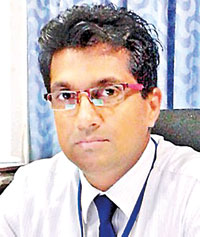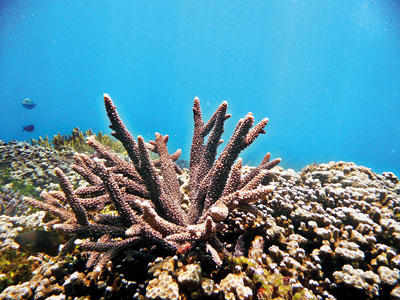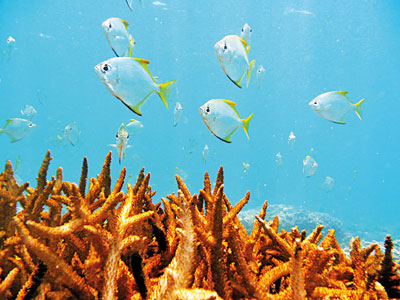Sunday Times 2
Ambitious bid to save Lanka’s remaining ‘untouched’ reefs
“It was no different to a fish tank — clean and colourful,” is how Oceanographer Dr. Terney Pradeep Kumara reflects upon the Hikkaduwa coral reef in the 70s and 80s.

Dr. Terney Pradeep Kumara
“When the area started attracting tourists, residents of the area set up their own businesses from small scale hotels to glass-bottom boat rides, and by the time government realised Hikkaduwa’s potential as a tourist hot spot, the resident-centric tourism industry of the area had gone a long way to a large extent, unregulated and unplanned,” notes Dr. Kumara, the General Manager and Chief Executive Officer of Marine Environment Protection Authority (MEPA) and Senior Lecturer at the Ruhuna University’s Department of Oceanography and Marine Geology.
The same scenario, as he says, was replicated in Unawatuna. This happened at a huge cost; both socially and environmentally, he adds. The unplanned ad hoc tourism industry which abetted environmental hazards and drug abuse was furthering its reach to the other coastal hot spots, including Mirissa, which is notable not only for unauthorised constructions on the beach but also for illegal fishing methods. “So much so, endangered species such Tomato Hind or locally called thambuwa (Cephalopholis sonnerati) and Juvenile Lobsters are sold in the open market with no heed to the laws governing protected species,” says Dr. Kumara.
In an ambitious move to regulate the remaining ‘untouched’ coastal areas including reefs and declare them as Marine Protected Areas (MPAs), MEPA has spearheaded an Inter-Agency Coordinated Mechanism to protect marine ecosystems. For this purpose, it has teamed up with multiple stakeholders such as NARA, NAQDA, the Wildlife Conservation Department, the Fisheries Department, the Forestry Department, the Coast Conservation Department, the Central Environmental Authority, the Tourism Ministry, the SL Coast Guard, the SL Navy, UNDP, IUCN, local councils and the Blue Resources Trust. This initiative will zone and regulate marine attractions including coral reefs and fishing. The pilot project as the Sunday Times learns is already off the ground at Kayankerni, off Kalkudah in the Batticaloa District.
As Dr. Kumara points out, the Kayankerni reef, with a host of diverse corals and other vibrant marine and plant and animal life, is a rich tourist attraction. It is also home to 207 fish species and invertebrates and sea grass. Kayankerni is also of particular importance due to the historic shipwreck sites located adjacent to the reef. The British Sergeant, a merchant vessel that sank after coming under fire when it altered its course to help a carrier in 1942 and SS Lady McCallum, a cargo ship which ran aground in 1926, are located on the sea bottom off the Kayankerni reef. The potential for shipwreck tourism the area offers is enormous.

Nishan Perera
Several threats to the reef have been identified as Dr. Kumara explains. These include unregulated and illegal fishing activities, ornamental fishing, recent developments in the tourism sector, setting up of aquacultural farms and a lack of community support and awareness at community level about the importance of coral reefs. “The reef area has already been mapped out and zoned. Moreover, a survey on land-used patterns has also been completed,” points out Dr. Kumara, assuring that by the end of this year, Kayankerni reef area would be declared a protected area following gazette procedures and biodiversity assessment by the Wildlife Conservation Department. “A survey on the users of this area, especially the reef region and procedures to register the fishermen and their fishing gear are also in the pipeline,” he notes.
The MPA concept will operate on the cornerstones of ‘managing and conserving’ and engage the local communities. “Once people are managed, the environment will naturally be managed in a sustainable manner,” says the MEPA GM, adding that community participation for the protection of Kayankerni reef is a top priority of the project. He adds that the experience in the Kayankerni will be replicated in other similar zones in Mannar (Viduthalaithivu) and Mullaitivu. “Ideally the exercise should be translated to inland potential tourist attractions as well,” says Dr. Kumara who urges the responsible authorities to take a cue from MEPA’s brainchild.

Kayankerni reef, a beauty to behold
Speaking to the Sunday Times, Marine Biologist and Co-Founder of Blue Resources Trust, (based in Kalkudah) Nishan Perera, a partner in the Kayankerni project, notes that Kayankerni reef is one of the last remaining healthy coral reefs in the country with relatively lower human impact compared to many other reefs and has had less impact from the 2016 coral bleaching event.
“It is, therefore, potentially an important source of coral and fish larvae to repopulate other reefs along the East Coast. The reef may also provide important information on reef resilience in Sri Lanka to coral bleaching. Management efforts should, therefore, be focused towards conserving such important habitats as biodiversity refuges. It is also important to ensure that management actions are taken early, rather than once major degradation has occurred or human impact has increased.” High population density, over-reliance on marine resources and poor management are responsible for reef degradation in Sri Lanka, says the marine biologist.
His organisation’s research findings on the Kayankerni reef, as Mr. Perera explains, has revealed more resilience to coral bleaching and its ability to recover from ‘events of disturbance.’
“This may be impacted by local biological and physical factors such as availability of coral larvae, wind and current patterns and temperature fluctuations. However, more research is needed to better understand this,” he says.

Breathtaking marine life surrounding the reef
Commenting on the importance of engaging host communities in managing reef resources, he surmises: “Community-based management and ownership is vital for management of reef resources. However, this requires community empowerment and more collaborative management. Many innovative solutions used in other developing countries have not yet been adopted here. They include joint patrolling and disbursement of income to local communities. It is important that local people have ownership, rights and also benefit from income derived from a protected area.”
Mr. Perera remarks that community-based management is more likely to succeed in areas with lower human pressure and less outside influence, as it enables to structure a management system before the situation becomes complicated. “The East Coast and certain parts of the North are ideal for this. It may also be possible to develop specific fishery management plans with local communities for some target fisheries,” he adds.
* Photo Credit (Kayankerni reef): Dr. Terney Pradeep Kumara

